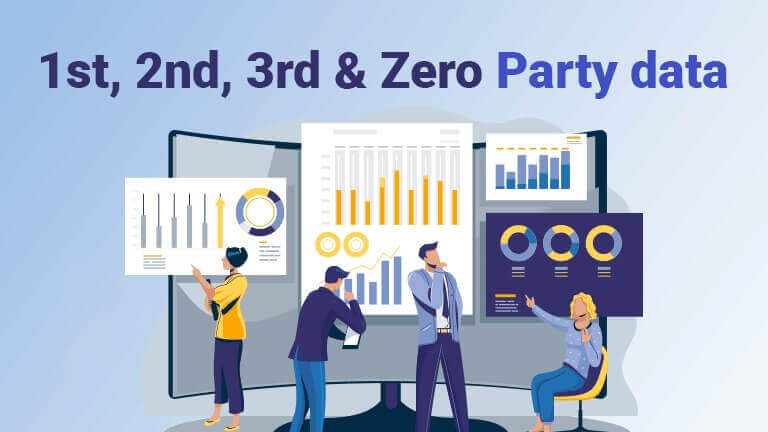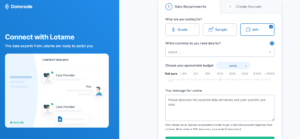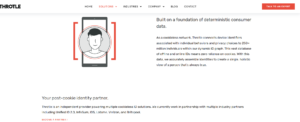
We are knit into a world of data ever since the Internet came into our daily lives. B2B companies who are working in Technology, Data Analytics, Digital Marketing, AI, and Customer Service have to juggle so much data to add value to their service.
Back in the late 90s, data could be retrieved by technologists through hidden codes and so on. Later on, such data could be taken and stored on the servers in the form of Cookies. Today, this party data has transformed a lot. Today, there are various levels at which data can be taken from a customer when they visit your website.
Table of Contents
If the customer is king, then the data about them is the real pathway to reach them. If you are new to the world of digital marketing, this is one area that you would need to dive in. It is particularly useful for
A customer data platform (CDP) centralizes customer data in one place, from which marketers, sales reps, and customer success managers can run analyses to better understand audiences.
CDPs are primarily focused on collecting and aggregating first party data, but they can also store second and third party data as well.
Let’s navigate through the various types of Party Data
The concept of First party data means the type of data that has been collected by the company from the supposed site visitor. This could be a client, an interested sales lead, a third party, or even fellow competitors.
Most importantly, this data is compiled directly by the company web system and is considered unique information.
Get the information first hand: Firstly, this has no third person involved. This makes a great option to study your end user on a complete basis. For those B2B companies, who need to launch a specific product or service, first party data will be your Kickstarter information.
Transparency: There are no chances of false information, as the users have the space to share their opinions, and queries directly in the system. The whole data will get collected in real-time, giving no space for discrepancy or data fabrication of any sort.
Simple customer behavior study: This form of data collection is simple and helps digital marketing teams to understand what the audience feels and can also get information on various suggestions on this subject.
Retargeting made easier: Yes, this is one huge benefit that you can gain from first party data. Since you get an idea of who actually needs your products or services, you can focus on retargeting your marketing campaigns in a more planned, sustained, and revenue-generative model.
This is in fact simple if you have developed an automated CRM system for this purpose. Any information that is recorded first hand will fall under this category. This is submitted knowingly and willingly by the customer or app user.
Here tracking pixels are embedded into the system to monitor your IT products, whether it is a website, mobile application, or even social media profile. For instance, if you have an e-commerce website, when a user clicks on an image, a link to a product, or asks a query every touch, movement, and usage pattern is tracked in detail. The pixels will collect and record each of these specific actions. Take a look at the variety of ways that first party data can be collected from visitors.
You can collect the information through various interesting channels or modes. All the below listed ideas can form part of the website CRM, thereby further breaking down the customer needs at large.
From the first, we hop into the Second Party Data. As the name indicates, we are not the first retrievers of the information. It would have been received from some other source and just passed to us. That’s why we call it second hand party data.
You may have seen a lot of information and research based companies that collect data randomly for their surveys and prepare yearly reports on a variety of subjects. They are great insights about the audience at large. We, as the recipient company can subdivide the data for our use as needed. Such data is given in a totally mutually beneficial business relationship. If you do not have the expertise and the team to gather first party data for you, it is always better to take assistance from such agencies that furnish second party data.
Let’s take an example. Suppose you need to know the credit card used for airline and flight purposes in a certain period of time in Australia. You may be established in Mexico. How would be tracking the way your prospective users are handling their credit payments?
Get Information ready in no time: You need not be there in the country physically for the research phase. Instead, fix specific based goals with your agency and work on your product marketing strategies in the meantime.
Build Predictive Models: Use this second party information along with the first party information and build suitable predictive models to understand your end user better. It is particularly useful when you have introduced a niche product and are still on the hunt to find out more about customer preferences.
Know your audience better: Yes, when you start off with any product, website, or any business for that matter, you may have a little bit of knowledge. Well, customer preferences change over time. Trends and competitor businesses also change. These surely affect the final sales. That is what you get to know through the wide information shared by these second parties.
Well, that is not directly from your end. For instance, if a data collection agency, has conducted a recent survey for the use of credit cards by ladies in Houston, you can always buy the information.
This gives you more insight into the age group of the ladies, their approximate professional capacity, their usage of credit cards, and the spectrum of expenditure interests (fashion, education, self-care, and more.
Make sure that you talk in detail with the data collection agencies. Let them get a clear picture of your marketing goals and then they can re-organize the data and deliver the information to you. This way, you can use the data that is shared after proper filtration.
As mentioned earlier, there are plenty of sources for this. In case you are launching your brand in a new nation or location, these specialized teams will be your biggest backup support.
Moving onto the next level of data collection, we have third party data sources to depend on also. Unlike second-party data agencies, here, they do not collect data by themselves. The third party data companies have access to a lot of information, but these are not directly collected by them as such. These agencies pull the data from data aggregators and pay them for this large amount of information. It will be mixed and not filtered like in the case of second party data.
At one glance, marketing teams may find this as a quick source of data. But understand that this will have a lot of information – some of which may be needed and some of which may not be needed, So, digital marketers need to do two things to make their data more result centric.
If you ask about the process of data collection, it would be the same as the way the first data and second data are collected. But the amount of data is relatively huge.
Researchers in such agencies will use feedback forms, questionnaires, quizzes, fun posts, and engagement videos across social media channels to collect information. Plus, you may have seen random reviews being asked when you visit a store or visit a website. Perhaps you have received such emailers too. Such options will get more participants and responses that are willingly given by users across the web and even offline modes.
There are plenty of third party data aggregators in the market. You can talk to them, fix the best packages for data and get the data in a lump sum.
With actionable customer data intelligence reports, they help their International clients to upgrade the product and customer journey in a holistic manner, Their data is their marketplace and clients can ask for customized reports and data compilations as per the need of the product or projects at hand.

The company helps brands strategize and build the perfect customer-brand relationships through realistic data driven solutions. From addressing personal touchpoints to macro level competition, the data is a boon to many companies today.

The much talked about Zero Party Data is still not clear to many. So, we felt that we need to ease out the confusion on this matter here.
Zero Party Data is very different from the other three types. In previous situations, if you need information, you had to ask the user through multiple options. Whereas, here the end user proactively comes forward to give in their information.
This willingness makes the information all the more authentic and personalized for the company and the brand.
Let’s take an example of the new toy shop launch. Or perhaps an innovative beer, a nonalcoholic brand is taking shape. Or let’s just take a beauty brand that focuses on colored people. There is a huge market for all these segments, as there are people who genuinely want products like these.
Take Sephora for instance. They have been working on zero party data for quite a few years. They ask customers about various beauty experiences. This reveals the user interest levels and even gives a platform to help suggest new products in the making.
Similarly, stroller companies have been taking surveys taken from pregnant women and first time fathers. Their journey has been noted throughout the three trimesters and once the toddlers were born, strollers were given to them. This way, they could try and share their experiences. If this needed an improvement, it would be a wholehearted opinion by a parent. So, this added all the value addition and personalization
Here the data is collected in the form of
Though you won’t find a huge rush of clients overnight, the people who approach your company, those who are willing will be glad to share their opinions and preferences if given a chance. This is what is needed to augment customer preferences.

| Sl No. | Parameters | First Party Data | Second Party Data | Third Part Data | Zero Party Data |
|---|---|---|---|---|---|
| 1 | Consent Level | They are willing to share the information | Consent obtained from customers | Consent obtained from people who participate | Customers come forward to give opinions |
| 2 | Relationship | Direct relation | Indirect relation | Indirect and totally unknown relation | Direct relation |
| 3 | Types of Data | Email id, opinion polls, purchase and browser history | Surveys, website usage data, fill up forms, etc | Surveys, feedback forms, quizzes, website query forms, internet usage reports, etc. | Customized calls, form interactions, personalized expert discussions, etc. |
| 4 | Accuracy | High accuracy | Medium accuracy | Low accuracy | High accuracy |
| 5 | Shareable data | Only collected for the company and not shareable | Is shareable with other third party clients | Is shareable with many clients | Only collected for the company and not shareable |
| 6 | Trust Level | High trust | Moderate trust levels | Low trust levels | Trusted for a lifetime |
| 7 | Customer Loyalty | High Loyalty | Medium Loyalty | Low Loyalty | High Loyalty |
| 8 | Customizable | Customized Data queries | Data collection not customized | Data collection not customized | Customized Data queries |
| 9 | Time Span | Quantity obtained | Data obtained in weeks, but small quantities of data are received | Reasonable data will be received quickly to start the product marketing | Large amounts of data will be received in a short while (like few days) | May take months to years to obtain the customer views |
| 10 | Expense | Free, collected by own team | Paid packages | Paid packages | Free, collected by product development experts |
Stepping on data privacy is delicate and had to be handled with care. Although we have mentioned the existence of third party data, this proportion of data aggregators will reduce over time. Then only the First party and zero party will exist.
Cookies have been helping companies for a long time to collect various types of consumer related data. But this had gone beyond the line and consumers seemed disturbed about this. With the lack of transparency on how their data will be used or rather manipulated, people chose to stay invisible or silent.
Giant browsers like Google are taking the steps to protect their consumers in this line. Apple has already given its users the option of opting out of third party cookie tracking and keeping their privacy intact.
For this B2B companies will have to think ahead of time and the first step would be first party data always. A few things you would need to keep in mind:
The mode of data strategy will help B2B companies and even new age research companies make good the loss of fewer data nowadays,
Whether you have a well established product like Apple or a new launch product, it doesn’t matter today. You ought to personalize customer experiences. As detailed out above, this keeps your customers on the upper edge of trust, happiness, and communication – when you personalize each of the conversations.
Let it be online or offline, let it be a survey or a casual mailer, but make them feel the need to spill out what they need. That will make your data strategy move from first party data to zero party data.
To understand this further on, stay tuned with us, as we explain each of the marketing strategies for various Business niches in terms of digital marketing right here.
Founder & CEO @ LogicRanks, (Simply Put, I’m in charge of this exciting venture and we’ve some EPIC blogs taking shape). Gotcha 14+ year entrepreneurial ride where I have donned the "Strategic digital marketer and multi-faceted business consultant” cap. That got me unfolding these awesome blogs published here. Nonetheless, my versatile experience & learnings in real-time, proven digital marketing ventures & notable business journeys are wrapped with innovation, research, and result-oriented accolades. Stay with me on this journey :)
Related Blog Posts
Guerilla Marketing Ideas that Leverage Business Visibility
Omni Channel Marketing: How it Perfects Omni Channel Commerce?
Omni Channel Commerce: How to Provide Seamless, Unified Shopping Experiences?
Top Marketing Platforms to Grow Businesses
The Consumer – Omni Channel Distribution Relation
Dental Marketing Ideas to boost sales for Dental Clinics and Hospitals
37 Video Marketing Ideas to improve your video marketing
Top 63 Social Media Marketing Ideas for improved brand visibility